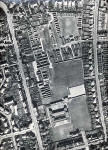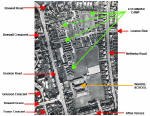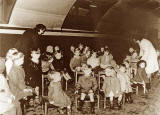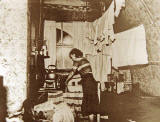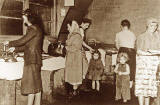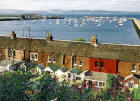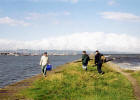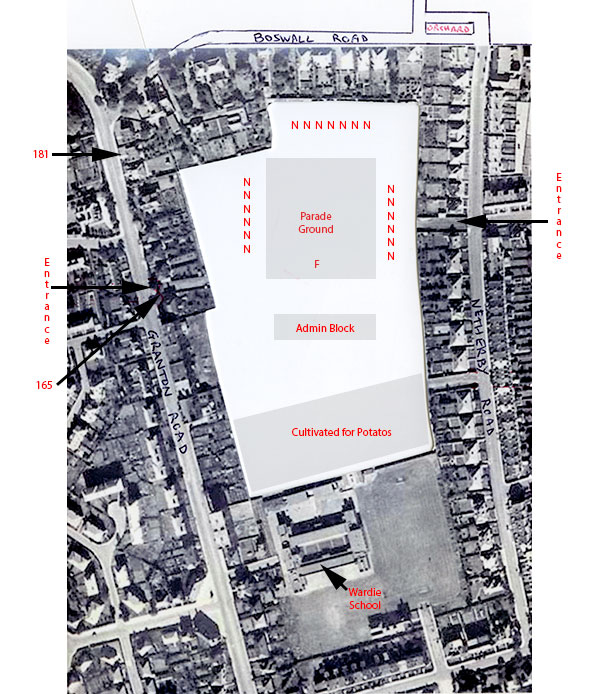Recollections Lochinvar Camp 1940s and 1950s |
||
|
PRESS REPORTS |
||
|
1946 Aerial View 1951 1956 |
||
|
RECOLLECTIONS |
||
|
1. |
Shetland, Scotland |
From 1946 |
|
2. |
Edinburgh |
Buildings Families Mixed Recollections |
|
3. |
Somerset, England |
Overspill |
|
4. |
Kinghorn, Fife, Scotland |
Navy Small Home at Lochinvar Mixed Recollections 'Homes for the Homeless' Protest March |
|
5. |
Somerset, England, |
Navy Camp |
|
6. |
Donald
Grant |
Granton Road House Back Garden Emigration |
|
7. |
Bert
Fairburn |
My Family Our Homes Emigration |
|
8. |
Robert
Hamilton |
Age 5 Our Family Scottish Community Singing Memories |
|
Press Reports Emergency Housing Site |
||
|
1946 During World War II Lochinvar Camp was a Naval training establishment, but following the end of the war, in 1946, it passed to Edinburgh Council and was used to house homeless families that did not qualify for council housing. The camp was on the northern half of Wardie Primary School playing fields, Granton Road, about half a mile to the south-east of Granton Harbour. Lochinvar camp can be seen in the aerial view below, taken in 1947. When I knew the Wardie School playing fields in the 1970s, they were still sometimes referred to as 'Lockies'. Lochinvar Camp key |
||
|
1951 An article in the Evening Dispatch newspaper on November 16, 1951 described the camp as Edinburgh's third largest housing site and easily the most habitable of the city's camps. At that time there were 168 families living in the camp, living in a barrack block, Nissen huts and new wooden huts, with communal kitchens and washhouses. The charge for a two-apartment home was 12s 6d (=62p) a week. [The UK average weekly wage in 1951 was £8 8s 6d (=£8.42).] The article said that in the oldest part of the camp there were only three basins and two baths to be shared by the men of 25 families: |
||
|
1951 Comments Here are some comments from the Evening Dispatch article:
Nevertheless, the children were reported to be healthy with the sea air and the residents were quoted as saying:
|
||
|
1951 Photos The article was accompanied by photographs of: - a crowded kitchen - a kindergarten run by two voluntary workers - children playing in a large puddle and a Nissen hut with painted slogan 'A Hero's Welcome Home!!" Here are some of the photos: |
||
|
1956 Five years later, the Evening Dispatch reported : - The city's other camps at Duddingston, Craigentinny and Sighthill. had already closed. - The 71 families living in Lochinvar Camp at the end of 1955 had all now been re-housed - the final residents, George Carson (caretaker) and his wife and four children, moving out of on October 31, 1956. This article referred to the camp as:
It apparently did not take long to demolish the camp after the last residents moved out. In October 1956, the Evening Dispatch reported:
|
||
|
Edinburgh Dispatch November 16, 1951 and October 31, 1956 |
|
Recollections 1. Duncan Shedden Shetland, Scotland |
|
|
From 1946 Thank you for the message sent to me by Duncan Shedden who tells me that he was born in Lochinver Camp in 1946 and lived there for a few years, attending Granton School, then David Kirkpatrick school, Leith He later moved to stay with his Grandad at 4 Royston Mains Gardens and attended Royston School. His Grandmum staid at West Pilton Drive North, so Duncan knew the old Embassy Picture House quite well. Duncan then moved to Leith Links. Around the mid-1970s, Duncan moved to Shetland and is still living there. Duncan is now trying to trace his childhood, and looking for information and any close-up photos of the camp Duncan's Dad was Peter Burns Shedden, Royal Navy. Duncan says:
Here are views taken from Wardie Steps and Granton Eastern Breakwater, a few decades later: |
|
|
Duncan Shedden, Shetland, Scotland: December 10 + 13, 2005 |
|
Recollections 2. Allan Hosey Edinburgh |
|||
|
Thank you to Allan Hosey for passing on his parents' memories of Lochinvar Camp. Allan wrote:
|
|||
|
Allan Hosey, Edinburgh: December 7, 2006 |
|
Recollections 3. Jack Wilson Somerset |
|
|
Thank you to Jack WIlson who wrote:
Thank you to Jack for also sending memories of Granton and T L Devlin's yard |
|
|
Jack Wilson, Somerset, England, January 6 + 7, 2007 |
|
Recollections 4. Peter Shedden Kinghorn, Fife Scotland |
|||||
|
Thank you to Peter Shedden who wrote:
|
|||||
|
Peter Shedden, Kinghorn, Fife, Scotland: March 3, 2007 |
|
Recollections 5. John Stevenson Trinity, Edinburgh |
|
Others have written above about Lochinvar Camp when it was a camp for the homeless following the ending of World War II, such as soldiers returning to towns on the Clyde who found themselves homeless, their homes having suffered bomb damage. Here is an aerial view of the camp, taken in 1947, when it was being used to provide social housing Camp for the Homeless Wardie School Grounds - 1947 © Reproduced courtesy of RCAHMS However, here John Stevenson (who lived nearby and went to Wardie Primary School, adjacent to the camp from 1937 to 1941) recalls the wartime years when Lochinvar was a Navy Camp with a lay-out similar to the sketch below. |
|
Lochinvar Navy Camp Beside Wardie Primary School - Around 1940 © Reproduced courtesy of RCAHMS. N N N = area of Nissan Huts. F = Flagpole Sketch of the Navy Camp around 1940, based on discussions with John Stevenson
|
|
John recalled Home and School "I grew up close to Lochinvar Camp. I lived at 181 Granton Road and attended Wardie Primary School from 1937 until 1941. The house and school are shown in the sketch above. The public were not allowed into the camp, but I had a good idea of the general lay-out from what I could see from our house. The large potato patch at the southern end of the camp prevented us looking too closely at the activities of the sailors from our school grounds." The Parade Ground "I remember that you could look into the camp from the entrance in Granton Road, and see the flagpole on the Parade Ground, in line with the entrance. We used to be regularly woken in the mornings by sound of the bugle at 6am. The area where the Parade Ground was built was waterlogged when the navy moved into the camp. This was due to Wardie Burn running through the camp. So the Parade Ground had to be built on a substantial concrete base." Camp Entrance from Granton Road "There was a sentry box on either side of the entrance to the camp from Granton Road, and a Guardroom beyond them on the right as you entered the camp. The sailors at the sentry boxes had white gaiters and carried guns. They had a white bull terrier which had become their mascot after having been given to them by Mr & Mrs Wilkie who lived at 165 Granton Road, beside the camp entrance. The Wilkie family owned two old-fashioned ironmongery shops in Leith, one in Junction Street and the other in Coburg Street - the sort of shop where they would weigh out 4 oz of nails for you." Camp Entrance from Netherby Road "There was also an entrance to the camp from the east, from Netherby Road. This was never used, except by sailors who arrived back late late and climbed over the gate and into the camp." Boswall Road Orchard "The sailors were frequently tempted to help themselves to apples in the small orchard in Boswall Road, near the NE corner of the camp, now the site of modern houses. But old PC McBeth, who had been called back from retirement on the outbreak of war to serve with the Police for a few more years,, was aware of their activities and used to catch them. PC McBeth had an old, heavy Police bike. When we saw that it had been left close to railings, we used to tie it to the railings with an old rope, then watch as he tried to dash away on it." John D Stevenson, Trinity, Edinburgh: January 28+29, 2014 |
|
Recollections 6. Donald Grant Penicuik, Midlothian, Scotland |
|
Thank you to Donald Grant who wrote: |
|
Granton Road House beside Lochinvar Camp Entrance "I was interested to read the comments from John Stevenson regarding the camp, in particular the section relating to the camp entrance in Granton Road. He mentions the occupants of the house next to the entrance, number 165 Granton Road. My late brother, Iain, bought this house and moved in with his family in the 1970s, living there for a number of years. I recall one incident relating to the camp whilst they lived in the house. By then, of course, the camp was long gone and the site was playing fields used by Wardie Primary School on occasion, but also the home ground of Broughton School's former pupils' rugby club. It was also used one or two days a week by Hibs football club before their training facility was opened near Tranent." Back Garden Metal Object Found "One Sunday, Iain was working in the back garden digging over his vegetable patch when his fork hit a metal object as he turned over the soil. It was immediately obvious that he had what looked like an unexploded bomb and so he telephoned the police who, in turn, contacted the army's bomb disposal unit. However it wasn't quite as dramatic as first thought, as it turned out to be an anti-aircraft shell which had probably been fired from the camp. It was quite safe though, as it did not contain any explosive material, it was just a solid metal missile. The army explained that there were anti-aircraft guns in the camp and that (as we all know) what goes up must come down. On that basis it's probably safe to assume there are more still buried undetected in the gardens of the surrounding area, possibly even in the playing fields too." Granton Road Traffic Accident "Some of your site visitors who lived locally may remember a local incident that occurred involving Iain in the 1970s. He left home one morning to drive off up Granton Road to work. As he got to the junction of Granton Road and Afton Terrace a bus driver heading north down Granton Road suddenly decided to overtake a car that was waiting for Iain to go past so it could turn right into Afton Terrace. The resulting collision sent Iain's car (a Mk 1 Ford Escort) spinning away causing it to crash through the garden wall on the corner of the junction. When the car came to rest Iain was left heavily shaken and bruised with the gear lever in his hand and the engine pushed into the front passenger foot well. I believe that wasn't the first (or last) time the garden wall had suffered damage because of a collision! Even today I can still see where the rebuilt section of the wall is as it looks slightly rougher than the rest of the wall." Donald Grant, Penicuik, Midlothian, Scotland: 3 February 2014 |
|
Recollections 7. Bert Fairbairn Gold Coast, Queensland, Australia |
|
Thank you to Bert Fairbairn who wrote: |
|
My Family "I was born at 76 Lower Viewcraig Row Edinburgh in Nov 1945. My granny and grandad, Mima and Bert Jones, lived there. My mum was Ina, and her her sisters were Mary, Helen, Georgie Mima and Dorothy." I was browsing the net on the Dumbiedykes site and spotted a wedding picture my Aunty Dot was a flower girl in 1948. The photo was sent in by Jeanette Keighren." Our Homes "My granny' family moved to Moredun and my family moved to Lochinvar Camp at Granton then to The Inch, Liberton, until 1961. When we were living at Lochinvar Camp my father' Thomas Fairbairn' received a Bravery Award for saving a young girl whose dress had caught fire." Emigrartion "In 1961. we sailed to Melbourne Australia on P&O liner, 'Orion'. I've been sending info to my mum in Melbourne. She knew a lad Bertie Butters, and Pim Mackenzie and Betty Stewart who lived in Prince Albert Buildings." Bert Fairbairn, Gold Coast, Queensland, Australia: 23 + 27 February 2018 |
|
Recollections 8. Robert Hamilton Soest, Germany |
|
Thank you to Robert Hamilton who wrote: |
|
Age 5 "I was about 5 years old when I lived in Lochinvar Camp. I cannot remember when we moved there but it must have been soon after the War's end. We had been living with relatives in Stenhouse and then had to relocate to Lochinvar." Our Family "We were: - Mum and Dad - my elder brother, Eddie. - my and younger sister, Lilian. Scottish Community Singing "I know that we lived at Lochinvar for a couple of years and, truthfully, in my childish memory it seemed ok. In fact one of the best memories I have is in some sort of club they had there in which we always had Scottish Community Singing, which through that I still love today." Memories "I remember great big rubbish bins which we used to climb into and take and eat any apple peelings we found. YŁck! I remember having injured my leg and having to stay in bed for days, so Mum and carried me outside and there I lay and watched others playing. Granton beach was always a target for us ..The communal washrooms at the camp were great.". Robert Hamilton, Soest Germany: 31 August 2018 |
|
North Edinburgh Cramond - Granton - Royston - Trinity - Wardie |
|
|
Maps Granton: transport map 1932 Granton: small map 1870 Granton: large map 1870 |
Recollections Cramond: from 1940s Cramond Island: 1970s Granton: 1930s 1940s 1950s 1970s Granton, Trinity, Wardie: 1940s 1950s - 60s Shops Lower Granton Road all dates Muirhouse from 1930s Pilton: 1940 bomb Royston: from 1930s |
|
History Granton, Trinity, Wardie: from 1544 |
|
